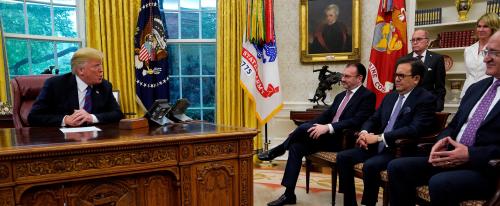Late Sunday evening, the U.S. and Canada announced they had reached a compromise in their negotiations to update the North American Free Trade Agreement (NAFTA). With the U.S. and Mexico having previously reached an agreement to update the trade pact, the three partners hope to sign the new deal a couple months from now, and ratify it sometime next year. What is this new agreement, how does it differ from the old NAFTA, and what does it mean for U.S. trade policy going forward? Here are five things to know.
- Overall, the changes from the old NAFTA are mostly cosmetic. After a year and a half of negotiations, the three parties are going to end up with a new trade deal that looks remarkably similar to the old NAFTA. The main structure of the deal is largely intact; the biggest changes include higher rules-of-origin requirements for the auto sector, marginally greater U.S. access to the Canadian dairy market, and a scale-back of the investor-state dispute settlement (ISDS) rules. Thus we shouldn’t expect to see any dramatic economic effects from this deal—though if it convinces businesses’ that U.S. withdrawal from NAFTA is no longer on the table, resolving this uncertainty may lead to a small increase in investment.
- The most revealing change might be the agreement’s new name. The United States Trade Representative press release announcing the new deal referred to it as USMCA, an acronym for U.S.-Mexico-Canada Agreement. This is, obviously, a terrible, unpronounceable name—but the shift itself is telling. It hints at the true underlying motivation for this renegotiation—Trump’s desire to overhaul the sullied “NAFTA” brand. On the campaign trail, Trump had denounced NAFTA as the worst trade deal ever; the administration seems to hope a new name will help sell these minor revisions as a substantial improvement. Yet, even if one accepts the idea of renaming the deal, there were some better branding options available to the negotiators: either MUSCA or CAMUS, for instance, would be far more pronounceable than the mouthful “USMCA.” Of course, neither of these alternatives would literally put “America First” the way USMCA does—perhaps explaining why they were passed over.
- The Trump administration got at least part of what it wanted. Coverage of the final U.S.-Canada talks have suggested it was a compromise outcome—the U.S. succeeded in winning a (modest) opening of the Canadian dairy market, while Canada persevered in preserving the Chapter 19 dispute settlement system and its special protections for Canadian cultural industries. While it’s true this was a compromise relative to the negotiating positions of the two sides, when judged against the standard of the previously existing NAFTA it’s clear the U.S. got more of what it wanted. Canada’s “victories” consisted of maintaining the status quo in many important areas; but while actual changes to NAFTA were modest, they were almost uniformly in the direction of what the U.S. wanted, and away from what Canada and Mexico wanted. Trump’s aggressive, threatening approach succeeded in eliciting modest concessions from two of its closest trading partners.
- While this might be a (modest) short-term victory for the U.S., it risks undermining America’s long-term interests. The fact that both Mexico (on autos) and Canada (on dairy) took some small steps to appease Trump’s demands should not be surprising—the U.S. is more important to their economies than vice versa. Does this imply Trump was right all along, that previous American trade negotiators had been foolishly taken advantage of? Hardly. Indeed, while the U.S. gained a few minor, discrete achievements in these talks, Trump’s approach in the renegotiations have likely undermined broader long-term American interests. As a global power, the U.S. has sought to exert influence by investing in “soft power,” the ability to convince other countries their own interests in fact align with those of the U.S. In seeking to squeeze a few more dimes out of Canada and Mexico, Trump is telling America’s allies that they should no longer be so inviting of American power. Since Trump’s election, a number of U.S. allies have already taken steps to balance against U.S. power, and diversify their interests away from America. The U.S. approach to NAFTA’s renegotiation should only accelerate this trend. In other words, the important question was never whether the U.S. could shake down its trade partners to extract some modest gains, but rather whether it should. Mexico and Canada won’t forget how the U.S. treated them—and will readjust their plans accordingly, as will other countries that observed these talks. In the long run, this will undermine America’s influence in the world.
- There’s still a long way to go until USMCA becomes law. By announcing the new deal by the September 30 deadline, the three parties are still on schedule for an official signing ceremony before December 1st, current Mexican President Enrique Peña Nieto’s last day in office. But that’s the easy part. The difficult step will be ratifying the agreement, which in the U.S. will mean a vote sometime in the next Congress. Clearly, how such votes proceed will be significantly influenced by this fall’s midterm elections. Yet whatever happens, there are reasons why both Republicans and Democrats may be reluctant to approve the deal. Republicans in Congress are wary of Trump’s protectionist instincts; Democrats, meanwhile, are unlikely to actively help Trump realize one of his key campaign promises. Thus, USMCA’s congressional path remains unclear. (Of course, for their part, neither Canada nor Mexico will likely protest too strenuously if the U.S. fails to ratify the new pact, so long as it allows them to keep the existing NAFTA.)
The Brookings Institution is committed to quality, independence, and impact.
We are supported by a diverse array of funders. In line with our values and policies, each Brookings publication represents the sole views of its author(s).






Commentary
5 things to know about USMCA, the new NAFTA
October 2, 2018